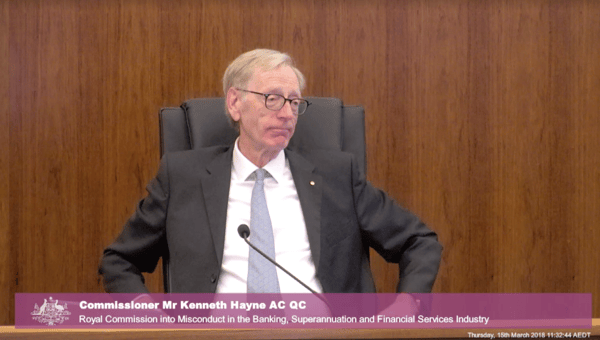Crisis Management Royal Commission Watch - Part 1
How storytelling techniques older than Christ brought an industry into disrepute - and how to halt the damage

This week in numbers:
- Over 1000 pieces of media coverage related to the Commission this week alone
- Nearly 40% of coverage on Tuesday mentioned “empathy”
- The “Royal Commission” has been discussed 222,364 times on social media this year
As we make sense of the task ahead for the industry - restoring trust - we’ll share our observations as communicators. There’s no silver bullet fix, but there are ways to stop, or slow, the reputational crisis.
The Commission announced this week it would spend more time on farming finance, following public and media pressure regarding the rushed nature of the inquiry. So there’s much more public scrutiny to come.
Watching the carefully constructed and unfolding story, it’s hard not to observe that lawyers, like marketers, PR people and politicians, know how to use the power of story. It’s devastatingly effective to highlight the facts, the character and emotion of the issues that sit under individual testimony.
With trust badly shaken, or broken, brands face risk to their business continuity as well as their reputations. Careers have ended abruptly and there’s a collective rethinking and reckoning that just a few months ago seemed implausible.
We remain in a defining perception crisis for the Australian finance sector.
So how do we now navigate the changed perceptual landscape created by Australia’s Banking and Financial Services Royal Commission?
The simple answer was to do the right thing, and communicate about it well. But arguably the time for that was decades ago.
Now, it’s a bit more complicated, and a long term exercise, to rebuild trust.
First, what’s “reputation” and how did it get broken?
For our purposes, reputation is the net value of how the public and stakeholders perceive, and support, a company or leader. Extreme events, with the power to radically change that perception (in any direction), are the most volatile times for reputations – with industry-wide events at the top of the list.
It’s worth asking how we got here - why has the Royal Commission narrative been so compelling?
The answer is literally older than Jesus: Aristotle’s artistic proofs – the three modes of persuasion: ethos, pathos and logos. In other words, ethical, emotional and logical support for our argument, whether in a legal trial, a public appeal, a media article, or a communications campaign.
We’ve seen all three used during the Commission. Logos is evident in the ongoing litany of facts – there’s no shortage of facts and figures at the individual, brand and industry level about the impact of corporate decisions.
How are moral credibility and emotional appeal used?
In any major event, humans look to familiar patterns as an explanatory lens – the algorithms of stories. Stories influence our way of thinking – we watch events unfold, and we extract defined meaning.
The word-to-picture exchange rate...
...You’ve heard that it’s a 1:1000. Well we can put a more exact figure on it – how many hundreds of thousand of words have been written about the Banking Royal Commission case studies? What number were negative, how many supporting?
Even an event like the Commission, with all its complexity, pulls towards the well-worn grooves of story patterns. Spectators look for familiar landmarks of a narrative arc: building tension, climax, resolution – and recognisable characters. These inflection points and archetypes hold power.
We’ve seen this unfold in recent weeks. The last round of hearings didn’t fully capture public imagination – there was ambiguity in the villain and the victim, in the nuances of culpability. But this round of hearings, with its droughts, floods and fires, cancer and heart attacks, and hardworking families rent asunder, has all the familiar features.
A story of men and women against institutions
Various voices told their stories last week. Farming families were at the centre. They held the most authenticity, and held up as genuine people, of character. The Commission itself, with its probing into what “the community“ expects and accepts, is surely making an ethical argument as much as a logical one. One point for ethos.
And the pathos of the people giving evidence is real. The damage is measurable and terrible. So the stories are incredibly powerful.
But not everyone telling the story is neutral. The way influencers, commentators and the media re-present these stories casts certain emphases. What conflicting forces are supposedly battling it out? Personally I’m uncomfortable with something that feels a fraction like McCarthyism and anti-institutional - it’s just all a bit too black and white.
We’ve seen a theme of culture clash emerge, with banks’ behaviour seen as incompatible and incomprehensible to the values of rural Australians and appeals to national pride¹. We’ve seen illustrations of intimidation against helplessness². We’ve seen the tension between man’s reason and emotion³. We’ve seen emphasis on our ‘humanity’ as the defining feature of our species, and on the drivers of greed and fear.
So, in the face of strong currents in perception, how do you mount a counter-argument? In other words, as the story is being written, what decides whether the epic is a tragedy, or a comedy of errors? It is the ending that classifies the story.
It isn’t a foregone conclusion.
When it comes to a company’s reputation, its leaders hold the pen. We can’t lose sight of the fact that leadership drives reputation in a crisis.
In the coming weeks and months, we will be looking at the various crisis management tools at leaders’ disposal to manage reputational risk. These tools are rarely used in isolation – they work in combination.
Flick of a switch
We began this week with our video on one of these strategies - the ‘Circuit Breaker’ technique. Did we see an effective Circuit Breaker campaign?
You can only tell with distance and hindsight. It’s not usually binary: rarely is it a case of 100% success or failure (except in cases of total dominance or collapse).
Certainly, announcements of sweeping management changes, and the selling off of business arms in conflict with each other – ahead of anticipated regulation of the same – could be categorised as such. So too could initiatives like industry-driven investigations into, and self-policed changes, of various arrangements and standards. And of course, the good, old fashioned apology takes the sting out of things if followed by action to repair the damage.
One potential circuit breaker was David Murray’s speech on the dangers of excessive regulation for the very borrowers it was trying to protect (credit tightening, driving them into the arms of unregulated providers). It’s a timely reminder that allowing free reign to a too-simple narrative misses a lot of necessary complexity.
He also got a comment in ahead of the week’s inevitable morality battle, by arguing “There's no such thing as a right or wrong culture. There's an effective or ineffective culture.”
Will it be enough to create an inflection point? I really don’t know - but it’s good a start.
Want to learn how to execute the 'circuit breaker' strategy? We'll show you how in this short video.
¹“We trusted these people”; “where I’m from if you do something wrong there’s nothing wrong with apologising but they’ve refused”, “We left a lot of people swinging…which didn’t sit well with us”; “ashamed to be Australian”.
²Reports of banks "circling" and backing borrowers’ against the wall; “bully” banker visits; “surprised he wasn't carrying a baseball bat”; “They came hunting for us, looking for us".
³The “story is a sad one but…we were…pursuing our contractual rights to get paid, managing money that belongs to our depositors…whilst it's a very sad list of events to read out and to listen to, I think the community would expect us to…recover the money that's owed."; “I know it sounds harsh and you can tell I am finding it hard to say this — when you analyse it clinically…we did what we said we were going to do”.











